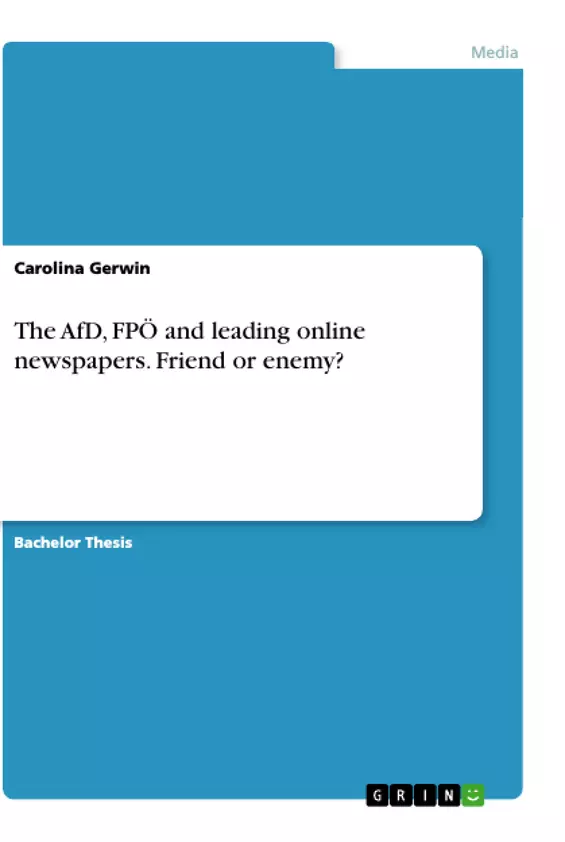This thesis examines how the right-wing populist parties AfD and FPÖ are portrayed in the media. In 2017, the right-wing populist parties “Alternative for Germany” (AfD) and the Austrian Freedom Party (FPÖ) got markedly different election results: While the AfD got 12.6 % of the vote share, the FPÖ achieved a much higher result with 26 %. Considering that the two parties as well as Germany and Austria are ostensibly similar, this puzzle leads to the question of what explains the so markedly different election results of the AfD and the FPÖ in 2017.
Based on a review of general factors that explain the success of populist radical right parties and extensive research on the aspects that led to the rise and success of the AfD and FPÖ, the paper focuses on the role of the media, seeking to understand how the two parties were portrayed by the media before the 2017 elections. This task is approached by conducting a qualitative content analysis of the reporting on the AfD by the Bild Zeitung and the depiction of the FPÖ by the Kronen Zeitung, the two most popular online daily newspapers in their countries, during the last month before the elections.
It is shown that the two parties used different framing strategies to report on the AfD or FPÖ respectively, resulting in a much more negative portrayal of the former. Considering that the FPÖ was depicted in a more positive way and got a much higher result in the election, the paper contributes to the literature by supporting the theory that the media have an influence on election results by shaping the public image of parties and their leaders, thereby influencing the voter’s perception of them, and offers a relevance point for further research on explaining the varied election results of the AfD and FPÖ in the 2017 elections.
Inhaltsverzeichnis (Table of Contents)
- 1. INTRODUCTION
- 2. LITERATURE REVIEW
- 2.1 General explanations
- 2.1.1 Demand-side explanations
- 2.1.1.1 Macro-level
- 2.1.1.2 Micro-level
- 2.1.2 Supply-side explanations
- 2.1.2.1 Internal
- 2.1.2.2 External
- 2.1.3 Interim Conclusion
- 2.2 Explanations for the success of the AfD and FPÖ
- 2.2.1 Demand-side
- 2.2.1.1 Macro-level
- 2.2.1.2 Micro-level
- 2.2.2 Supply-side
- 2.2.2.1 Internal
- 2.2.2.2 External
- 2.3 Conclusion
- 3. METHODOLOGY
- 3.1 Case selection: Media
- 3.2 Agenda-setting, priming, and framing
- 3.3 Qualitative content analysis – case selection
- 3.4 Qualitative content analysis- Data selection and evaluation
- 4. RESEARCH FINDINGS
- 4.1 Bild Zeitung
- 4.1.1 Volume of reporting
- 4.1.2 Evaluation of the AfD in the reporting
- 4.1.3 Sender
- 4.1.4 Topics
- 4.1.5 Attributes
- 4.2 Kronen Zeitung
- 4.2.1 Volume of reporting
- 4.2.2 Evaluation of the FPÖ in the reporting
- 4.2.3 Senders
- 4.2.4 Topics
- 4.2.5 Attributes
- 5. COMPARISON AND DISCUSSION
- 5.1 Volume and evaluation of reporting
- 5.2 Senders
- 5.3 Topics
- 5.4 Attributes
- 6. CONCLUSION
- The role of media in shaping public opinion towards political parties.
- The impact of framing strategies on the media's portrayal of political actors.
- The influence of media coverage on election outcomes.
- The comparative analysis of the media's portrayal of the AfD and the FPÖ.
- The success of right-wing populist parties and the factors contributing to their rise.
Zielsetzung und Themenschwerpunkte (Objectives and Key Themes)
This thesis aims to understand the different election results of the right-wing populist parties ‘Alternative for Germany' (AfD) and the Austrian Freedom Party (FPÖ) in 2017. Specifically, it explores the role of media portrayal in shaping public perception and influencing voter behavior. The research examines how these two parties were depicted in the lead-up to the 2017 elections by the most popular online daily newspapers in their respective countries - the Bild Zeitung and the Kronen Zeitung.
Zusammenfassung der Kapitel (Chapter Summaries)
The first chapter provides an introduction to the research topic, outlining the puzzle of the different election results of the AfD and FPÖ in 2017. The second chapter delves into a literature review, exploring general explanations for the success of populist radical right parties and focusing on the specific factors that contributed to the rise of the AfD and FPÖ.
Chapter three lays out the methodology used in the study, including the selection of case studies (Bild Zeitung and Kronen Zeitung) and the qualitative content analysis approach. Chapter four presents the research findings, analyzing the volume and evaluation of reporting on the AfD by the Bild Zeitung and the FPÖ by the Kronen Zeitung. The chapter further examines the senders, topics, and attributes associated with these portrayals.
Chapter five engages in a comparison and discussion of the findings, analyzing the similarities and differences in the media's depiction of the two parties across various aspects. This section provides insights into the framing strategies used by the two newspapers and their potential impact on public perception.
Schlüsselwörter (Keywords)
The thesis centers around the keywords: right-wing populism, AfD, FPÖ, Bild Zeitung, Kronen Zeitung, media portrayal, framing strategies, public opinion, voter behavior, election outcomes, qualitative content analysis. It investigates the influence of the media on electoral outcomes, focusing on the specific cases of the AfD and FPÖ in Germany and Austria respectively.
- Quote paper
- Carolina Gerwin (Author), 2019, The AfD, FPÖ and leading online newspapers. Friend or enemy?, Munich, GRIN Verlag, https://www.grin.com/document/509886



